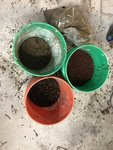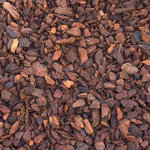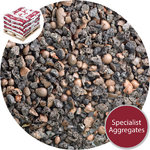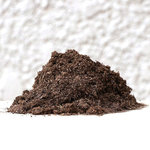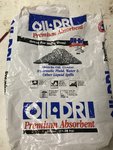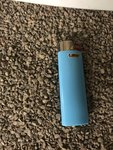Your fine moss looks like peat moss not sphagnum moss. What's the difference? Sphagnum moss is harvested live, then baled and dried. It is usually a straw color. Peat moss is different. It starts out as live sphagnum moss, dies, settles to the bottom of a pond, decomposes slowly for one or two centuries, maybe more. Then the bog dries out, and it is harvested. So the difference between peat and sphagnum is a couple hundred years. Peat is usually ground up and baled for sale, so a bale of peat is all very fine particles, making it very bad for bonsai. There are only a few situations where you would use peat moss. If you chopped up long fiber sphagnum, you chopped it too fine. Leave it mostly 1/4 to 1/2 inch particles. Too fine a chop and it will block the air voids in your mix.
Find a hydroponics store near you, the marijuana growers will have good materials for bonsai mixes on had.
Best main ingredient for a bonsai mix is pumice. If you can't find pumice - perlite is not too bad, though it is very light. A hydroponics store will carry the coarser grades of perlite, where average particle will be between 1/8 and 1/4 inch diameter, or the coarse which will be between 1/4 to 1/2 inch diameter for large trees. Perlite is excellent for a "grow out and size up mix", in that in large containers it poses no unusual problems. In very shallow containers, less than 1 inch deep it tends to float away. Top with a layer of long fiber sphagnum moss (the harvested fresh kind). and this will hold the perlite in place.
The crushed red lava is fine. Sift to eliminate fines.
Wood chips - the normal preferred ingredient is bark chips. Bark decays more slowly. Wood chips should never be more than 5 % of a mix or you may have problems with snow mold, and or wood decomposing fungi that are not also mycorrhizal. A little wood is fine to feed the mycorrhiza, but too much encourages the wood eating fungi that are not mycorrhizal, some can potentially become pathogenic. Orchid bark is a better choice. In the Minneapolis Area, Ordids Unlimited in Plymouth sells douglas fir bark in 2 or 3 sizes, the seedling grade is perfect for a bonsai mix. They probably have coarse perlite, horticultural charcoal, and maybe radiata bark, bark from the radiata pine - an equally good but somewhat different than fir bark, it lasts much longer.
The hydroponics stores will have fired or calcined clay products similar to Turface but in better size range for bonsai. They may even have pumice and lava. If you are going to go with locally sourced materials, or at least local store locations. Do hit your hydroponics growers.
At your farm supply stores, look for crushed quartzite, from New Ulm Minnesota - called Cherry Stone. Used as grit for chickens and turkeys. Best sizes for a bonsai mix are Grower, Layer and Turkey grit. with Turkey being the most coarse. Don't use more than 25 % in a mix because it will get heavy quickly and because it holds no water. It is essentially a inert gravel. But Cherry stone is a nice color. These days I don't use it in my mix, I use it as a top dressing to hide less attractive media below it. Then add some moss and you are ready for a show.

